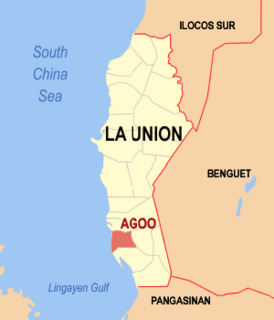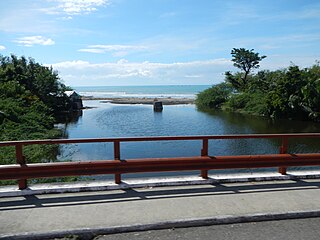
Metropolitan Manila, officially the National Capital Region (NCR), is the seat of government and one of three defined metropolitan areas in the Philippines. It is composed of 16 cities: the city of Manila, Quezon City, Caloocan, Las Piñas, Makati, Malabon, Mandaluyong, Marikina, Muntinlupa, Navotas, Parañaque, Pasay, Pasig, San Juan, Taguig, and Valenzuela, as well as the municipality of Pateros. The region encompasses an area of 619.57 square kilometers (239.22 sq mi) and a population of 12,877,253 as of 2015. It is the second most populous and the most densely populated region of the Philippines. It is also the 9th most populous metropolitan area in Asia and the 5th most populous urban area in the world.

Baguio, officially the City of Baguio, is a 1st class highly urbanized city in the region of Cordillera Administrative Region (CAR), Philippines. It is known as the Summer Capital of the Philippines, owing to its cool climate since the city is located approximately 4,810 feet above mean sea level, often cited as 1,540 meters in the Luzon tropical pine forests ecoregion, which also makes it conducive for the growth of mossy plants, orchids and pine trees, to which it attributes its other moniker as the "City of Pines".

Manila, officially the City of Manila, is the capital of the Philippines and a highly urbanized city. It is the most densely populated city proper in the world as of 2019. It was the first chartered city by virtue of the Philippine Commission Act 183 on July 31, 1901 and gained autonomy with the passage of Republic Act No. 409 or the "Revised Charter of the City of Manila" on June 18, 1949. Manila, alongside Mexico City and Madrid, was considered the world's original set of global cities due to its commercial networks being the first to traverse the Pacific Ocean, thus connecting Asia with the Spanish Americas, marking the first time in world history when an uninterrupted chain of trade routes circled the planet. Manila is also the second most natural disaster-afflicted capital city in the world next to Tokyo, yet it is simultaneously among the most populous and fastest growing cities in Southeast Asia.

La Union is a province in the Philippines located in the Ilocos Region in the island of Luzon. Its capital is the city of San Fernando, which also serves as the regional center of the whole Ilocos Region.

Agoo, officially the Municipality of Agoo, is a 1st class municipality in the province of La Union, Philippines. According to the 2015 census, it has a population of 63,692 people.

Tubao, officially the Municipality of Tubao, is a 4th class municipality in the province of La Union, Philippines. According to the 2015 census, it has a population of 28,729 people.

The 1990 Luzon earthquake struck the island of Luzon in the Philippines at 4:26 p.m. on July 16 (PDT). 3:26 p.m. (PST) with an estimated moment magnitude of 7.7 and a maximum Mercalli intensity of IX (Violent) and produced a 125 km-long ground rupture that stretched from Dingalan, Aurora to Cuyapo, Nueva Ecija. The event was a result of strike-slip movements along the Philippine Fault and the Digdig Fault within the Philippine Fault System. The earthquake's epicenter was near the town of Rizal, Nueva Ecija, northeast of Cabanatuan City. An estimated 1,621 people were killed, most of the fatalities located in Central Luzon and the Cordillera region.

The Balay Negrense, also known as Victor Fernandez Gaston Ancestral House is a museum in Silay City, Negros Occidental in the Philippines, showcasing the lifestyle of a late 19th-century Negrense sugar baron. It is notable for being the first museum to be established in the province of Negros Occidental.

The Saint Augustine Church, commonly known as the Paoay Church, is a Roman Catholic church in the Municipality of Paoay, Ilocos Norte in the Philippines. Completed in 1710, the church is famous for its distinct architecture highlighted by the enormous buttresses on the sides and back of the building. It is declared as a National Cultural Treasure by the Philippine government in 1973 and a UNESCO World Heritage Site under the collective group of Baroque Churches of the Philippines in 1993.

San Roque West is a rural barangay in municipality of Agoo, La Union, Philippines. According to the latest census, it has a population of 1,455 (2015) Majority of its population, Pangasinense is the language spoken making it as the only barangay in Agoo, La Union with official Pangasinense as language. Ilocano is also language spoken while English and Filipino are the medium of instruction in the schools.

The Basilica Minore of Our Lady of Charity, better known as Agoo Basilica, is a Roman Catholic Minor Basilica in Agoo, La Union, the Philippines dedicated to Our Lady of Charity. It is the seat of the Santa Monica Parish of the Roman Catholic Diocese of San Fernando de La Union under the Vicariate of St. Francis Xavier. The diocese of San Fernando La Union is part of the territory of the Archdiocese of Nueva Segovia. The basilica is under the leadership of parish priest, Msgr. Alfonso V. Lacsamana, PC and Parish Vicar, Father Liberato A. Apusen. It is situated along MacArthur Highway in Agoo, La Union in front of the Jose D. Aspiras Civic Center.

The Baliwag Municipal Library and Museum which is currently housed at the Lumang Munisipyo is the town’s center for historical and cultural heritage.
Archbishop Antonio Lloren Mabutas † was the first bishop of Diocese of Laoag and the second Archbishop of the Archdiocese of Davao. He succeeded Clovis Thibault, PME on 9 December 1972. He was also the President of the Catholic Bishops' Conference of the Philippines from 1981 to 1985.

The Aspiras–Palispis Highway is a Philippine major highway in northern Luzon that runs from the city of Baguio to the municipality of Agoo in the province of La Union.

Bacarra Church is a Roman Catholic church located in the municipality of Bacarra, Ilocos Norte, Philippines under the jurisdiction of the Roman Catholic Diocese of Laoag. The church was founded by the Augustinians, who dedicated it to St. Andrew.

The Agoo–Damortis Protected Landscape and Seascape is located on the eastern side of Lingayen Gulf in southern La Union, Philippines. It was established in 2000 to protect 10,648.94 hectares of coastal area, including mangrove swamps, seagrass beds and stretches of fine black sand beaches. It was first gazetted as a national park in 1965 and was known as the Agoo–Damortis National Seashore Park. It covers approximately 30 kilometres (19 mi) of coastline of the Lingayen Gulf shared between the municipalities of Agoo, Santo Tomas and Rosario.

The National Museum of Natural History is the national natural history museum of the Philippines. It is located along Agrifina Circle in Rizal Park, Manila.
Eufranio "Franny" Chan Eriguel, M.D. was a Filipino medical doctor and politician from the Eriguel political clan of La Union, who was gunned down in an ambush on 12 May 2018.

Museo de Intramuros is an ecclesiastical museum operated and managed by the Intramuros Administration. It is located at the reconstructed San Ignacio Church and Convent within the historic walled area of Intramuros in Manila, Philippines.

















